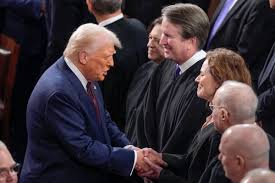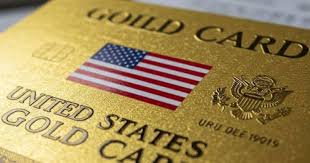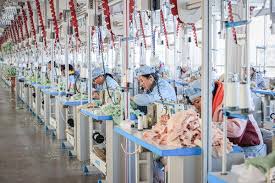Donald Trump’s use of tariffs as a crucial tool for foreign economic policy was undermined on Friday when a divided U.S. appeals court declared that the majority of the levies were unlawful.
To give the Trump administration time to appeal to the U.S. Supreme Court, the court let the tariffs stay in effect until October 14.
The ruling coincides with a legal battle over the Federal Reserve’s independence that appears headed to the Supreme Court, paving the way for an extraordinary judicial battle this year over Trump’s whole economic strategy.
During his second term, Trump has made tariffs a cornerstone of American foreign policy, utilizing them to renegotiate trade agreements and apply political pressure to nations that sell goods to the US.
Although the tariffs have created financial market volatility, they have also provided the Trump administration power to pressure trading partners into making economic concessions.
Trump posted on Truth Social, lamenting the ruling by what he described as a “highly partisan” court, saying, “If these Tariffs ever went away, it would be a total disaster for the Country.
He did, however, forecast a reversal, stating that tariffs would be advantageous to the nation “with the help of the Supreme Court.”
The validity of what Trump refers to as “reciprocal” tariffs placed in April as part of his trade war and a different set of duties imposed in February on China, Canada, and Mexico were the subjects of the 7-4 ruling from the U.S. Court of Appeals for the Federal Circuit in Washington, D.C.
Republican presidents appointed one majority judge and two dissenters, while Democratic presidents appointed six majority judges and two dissenting judges.
The court’s ruling has no bearing on tariffs imposed by other legal authorities, such as import duties imposed by Trump on steel and aluminum.
NOT COMMON AND EXTRAORDINARY
Trump used the International Emergency Economic Powers Act to defend both sets of tariffs as well as more current levy.
In times of national emergency, the president may respond to “unusual and extraordinary” threats under IEEPA.
“The statute bestows significant authority on the President to undertake a number of actions in response to a declared national emergency, but none of these actions explicitly include the power to impose tariffs, duties, or the like, or the power to tax,” the court stated.
“It seems unlikely that Congress intended, in enacting IEEPA, to depart from its past practice and grant the President unlimited authority to impose tariffs.”
Historically, the 1977 law has been utilized to freeze the assets of opponents or impose fines on them.
The actions were warranted, according to Trump, the first president to use IEEPA to impose tariffs, because of trade imbalances, the decline in U.S. manufacturing power, and the cross-border flow of medicines.
According to the Trump administration’s Department of Justice, the statute permits tariffs under emergency clauses that give the president the power to “regulate” or outright ban imports.
The U.S. has been importing more than it exports for decades, which prompted Trump to declare a national emergency in April.
Trump said that the ongoing trade gap was threatening American military preparedness and manufacturing capacity.
Trump said that the tariffs imposed in February on China, Canada, and Mexico were justified because those nations were not doing enough to prevent the illegal flow of fentanyl across U.S. borders.
The countries have refuted this claim.
ADDITIONAL UNCERTAINTY
The Trump administration had been anticipating this decision, according to William Reinsch, a former senior Commerce Department official who is currently with the Center for Strategic and International Studies.
“It’s common knowledge the administration has been anticipating this outcome and is preparing a Plan B, presumably to keep the tariffs in place via other statutes.”
The after-hours stock market did not respond well to the decision.
Art Hogan, chief market strategist at B. Riley Wealth, stated, “More trade uncertainty is the last thing the market or corporate America needs.”
Additionally, Trump is battling in court to have Federal Reserve Governor Lisa Cook fired, which may put the central bank’s independence in jeopardy.
“I believe it puts the Supreme Court and Trump’s entire economic agenda at risk of conflict. Josh Lipsky, chair of the Atlantic Council’s international economics committee, described it as “unlike anything we’ve ever seen.”
Although the conservative-majority Supreme Court, which has a 6-3 majority, has ruled in favor of Trump’s second-term agenda, it has also been against interpreting ancient legislation broadly to give presidents additional powers in recent years.
Two cases—one filed by 12 Democratic-led U.S. states and the other by five small U.S. businesses—argued that IEEPA does not permit tariffs, which led to the appeals court’s decision.
The lawsuits contend that Congress, not the president, is given the constitutional power to impose taxes and tariffs, and that any delegation of that power must be clear and constrained.
In its May 28 ruling, the U.S. Court of International Trade in New York declared that Trump had overreached himself in enforcing both sets of contested tariffs.
One of the judges on the three-judge panel was selected by Trump during his first term.
The administration has also appealed the outcome of another Washington court’s ruling that IEEPA does not permit Trump’s tariffs.
The state of California has filed one of at least eight lawsuits contesting Trump’s tariff plans.

















